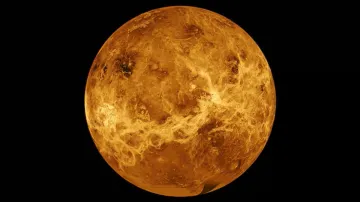ISRO plans Venus Orbiter Mission: List of successful and future missions to Venus
The government has approved ISRO's ambitious Venus Orbiter Mission (VOM), set for launch in March 2028. This mission aims to study Venus' surface, atmosphere, and volcanic activity, furthering India's space exploration goals.

The government has given its nod to several major space projects, such as the Chandrayaan-4, that has planned to collect samples of the moon and return back to Earth. The decision was taken when the Union Cabinet was meeting presided over by Prime Minister Narendra Modi.
The Cabinet cleared Rs 2,104 crore for the launching of Chandrayaan-4, a mission comprising several launches and a space docking exercise this year. This mission is after Chandrayaan-3 and has the main objective of giving a demonstration of the capability of returning lunar samples. Besides, Rs 1,236 crore was okayed for the Venus Orbiter Mission (VOM), which is set to be launched in March 2028. Incorporated in the VOM, Venus’ surface, atmosphere, and volcanoes will be analysed and the goal of the exploration is to explain how the radioactive planet changed from a possibly habitable one.
An overview includes areas such as Next Generation Launch Vehicles and Space Station Expansion.
The government has also sanctioned the build the Next Generation Launch Vehicle (NGLV) to provide the additional ‘heft’ required to send the heavy payloads necessary for the proposed Bharatiya Antariksh Station (BAS) as well as the planned manned lunar expeditions.
This will lead to the expansion of the Gaganyaan Program or the Indian human spaceflight program due to the increased cooperation.
The Gaganyaan program will be geared up with an enhanced fund allocation of Rs 11,170 crore, taking its total fund allocation to Rs 20,193 crore. It also involves the commencement of the first unit of BAS and technology demonstration by means of eight planned missions by December’ 2028.
Prime Minister's statement
PM Modi praised the cabinet decisions, saying that these measures will help India reach the set goals of having an independent space station by 2035 and the manned lunar mission by 2040.
"Great news for the space sector! The Union Cabinet has approved the first step towards the Bharatiya Antariksh Station (BAS), expanding the Gaganyaan programme! This landmark decision brings us closer to a self-sustained space station by 2035 and a crewed lunar mission by 2040!," Modi said in a post on X.
Venus exploration: A history of successful missions
Mariner 2 — First successful Venus flyby (1962)
NASA's Mariner 2 made the first successful Venus mission on December 14, 1962, capturing data on Venus’ extreme temperatures and solar wind. It marked humanity's initial planetary exploration beyond Earth.
Venera 4 — First atmospheric probe (1967)
The Soviet Venera 4 entered Venus' atmosphere on October 18, 1967, providing the first insights into its carbon dioxide-rich atmosphere, although it did not reach the surface.
Mariner 5 — Detailed Venus flyby (1967)
On October 19, 1967, NASA's Mariner 5 measured Venus' magnetic fields and atmospheric properties, contributing valuable data to understand Venus' atmospheric dynamics.
Later Soviet missions
Venera 5 and 6 — Atmospheric probes (1969)
In 1969, Venera 5 and 6 made successful flybys, sending data on temperature and pressure before succumbing to the harsh environment.
Venera 7 — First successful Venus Landing (1970)
Venera 7, on December 15, 1970, became the first spacecraft to land on Venus and transmit data, despite a rough landing.
Venera 8 — Successful landing (1972)
Landing on July 22, 1972, Venera 8 survived for 63 minutes, confirming Venus' extreme surface conditions.
NASA and Soviet achievements
Mariner 10 — Venus flyby en route to Mercury (1974)
NASA’s Mariner 10 used Venus' gravity to slingshot to Mercury, capturing close-up images of Venus.
Venera 9 and 10 — Orbiters and Landers (1975)
Both Venera 9 and 10 landed on Venus in October 1975, providing the first surface images and data on atmospheric pressure and temperature.
Pioneer Venus mission — Orbiter and Probes (1978)
NASA's Pioneer Venus, launched on December 4, 1978, consisted of an orbiter and multiple probes, providing extensive data on Venus' atmosphere and surface.
Recent missions
Magellan — Detailed Surface Mapping (1990)
NASA's Magellan, launched on August 10, 1990, used radar to map 98% of Venus' surface over four years, greatly enhancing our understanding of its geology.
Venus Express — European Orbiter (2005)
The European Space Agency's Venus Express began its mission in 2006, focusing on atmospheric and surface studies until its mission concluded in 2014.
Akatsuki — First Japanese Orbiter (2015)
Japan's Akatsuki, initially launched in 2010 and successfully entering orbit in 2015, has been studying Venus' atmospheric dynamics and clouds.
Contemporary missions
Parker Solar Probe and Solar Orbiter — Venus Flybys (2020s)
NASA’s Parker Solar Probe and ESA’s Solar Orbiter are using Venus flybys to adjust their trajectories for solar observations.
BepiColombo — Venus Flybys (2020 and 2021)
The BepiColombo mission, a joint effort by ESA and JAXA, includes two flybys of Venus as it heads toward Mercury.